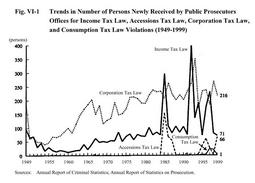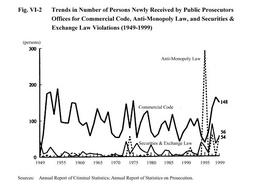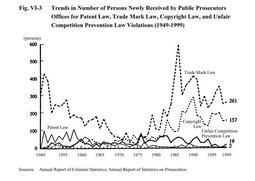| Previous Next Index Image Index Year Selection | |
|
|
1 Income Tax Law, Accessions Tax Law, Corporation Tax Law, and Consumption Tax Law Violations (see Fig. VI-1 )
The number of persons newly received by public prosecutors offices for Income Tax Law violations showed an upward trend in general from the early1960s, reaching a record high of397in1992. It stood at71in1999,down by9from the previous year. Cases of Accessions Tax Law violations have been reported since 1985,except in1989and1993. The number of persons newly received for the offense stood at66in1999,showing a substantial increase of64from the previous year. The number of persons newly received for Corporation Tax Law violations showed a general upward trend from the late1950s, reaching a record high of350in1993. It stood at216,down by52from the previous year. Cases of Consumption Tax Law violations have been reported every year since 1995. In1999,however, only1person was newly received for the offense, down by20from the previous year. During fiscal1999(April-March), the National Tax Administration made148accusations of Income Tax Law, Accessions Tax Law, Corporation Tax Law and Consumption Tax Law violations, which were transferred to public prosecutors offices. The average amount of tax evasion per case(including tax penalties for defaulted payment)was some¥210million for Income Tax Law violations(down16.7%from the previous year), ¥474million for Accessions Tax Law violations(down9.2%)and¥160million for Corporation Tax Law violations(down14.9%). The amount of tax evasion reached¥300million or more in24cases, and¥500million or more in7cases. Fig. VI-1 Trends in Number of Persons Newly Received by Public Prosecutors Offices for Income Tax Law, Accessions Tax Law, Corporation Tax Law, and Consumption Tax Law Violations(1949-1999) 2 Commercial Code, Anti-Monopoly Law, and Securities&Exchange Law Violations (see Fig. VI-2 ) The number of persons newly received for Commercial Code violations has exceeded100for three consecutive years since 1997. The number stood at148in1999,down by14from the previous year. Cases of Anti-Monopoly Law violations have been reported every two years since 1991. 56 persons were newly received for the offense in1999. In June1990,the Fair Trade Commission publicized a policy of actively filing criminal accusations for criminal penalties. The commission accused a total of146persons from1991to1999. The number of persons newly received for Securities&Exchange Law violations remained below20from1981to1993,but has exceeded that number since 1994,except in1996,reaching a record high of89in1997. The number amounted to54in1999,up by20from the previous year. After its inception in1992,the Securities and Exchange Surveillance Commission has accused a total of129persons by1999. Fig. VI-2 Trends in Number of Persons Newly Received by Public Prosecutors Offices for Commercial Code, Anti-Monopoly Law, and Securities&Exchange Law Violations(1949-1999) 3 Patent Law, Trade Mark Law, Copyright Law, and Unfair Competition Prevention Law Violations(see Fig. VI-3 ) The number of persons newly received for Patent Law violations has remained below 10 since 1991. It stood at 2 in 1999, down by 3 from the previous year. The number of persons newly received for Trade Mark Law violations showed an upward trend from the late1970s and reached a record high of592in1986. Subsequently, it has remained within the ranges of200and300. The number stood at261in1999,up by11from the previous year. The number of persons newly received for Copyright Law violations showed a general upward trend until reaching a record high of291in1990. Since then, it has fluctuated mostly within the range of100. The number stood at157in1999,up by5from the previous year. The number of persons newly received for Unfair Competition Prevention Law violations has shown a generally downward trend in recent years. In1999,however, the number increased to19,up by15from the previous year. Fig. VI-3 Trends in Number of Persons Newly Received by Public Prosecutors Offices for Patent Law, Trade Mark Law, Copyright Law, and Unfair Competition Prevention Law Violations(1949-1999) |


